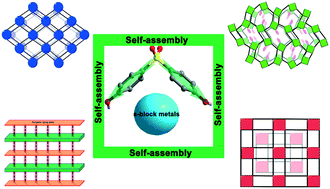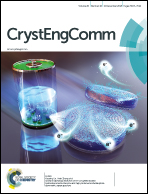Cooperative effects of metal cations and coordination modes on luminescent s-block metal–organic complexes constructed from V-shaped 4,4′-sulfonyldiphenol†
Abstract
The self-assembly of 4,4′-sulfonyldiphenol (H2sdp) with s-block metal salts in an aqueous or mixed H2O/alcohol solution gives rise to the formation of 13 new complexes, namely, [Li(Hsdp)(H2O)]n (1), [Na(Hsdp)(H2O)]n (2), [K(Hsdp)(H2sdp)(H2O)]n (3), [Cs(Hsdp)(solvent)(H2O)]n [solvent = EtOH (4) and i-PrOH (5)], [Mg(H2O)6]·2(Hsdp)·(H2sdp)·4H2O (6), [Ca(Hsdp)2(H2O)4] (7), [AE2(Hsdp)4(H2sdp)4] [AE = Sr (8) and Ba (9)], [Mg(sdp)(H2O)]n (10), [Ca(sdp)]n (11), [Sr(sdp)(H2O)2]n (12), and [Ba2(sdp)2(MeOH)2(H2O)]n (13), which have been characterized by elemental analysis, IR spectroscopy, TGA, PL, and powder and single-crystal X-ray diffraction. The smaller Li(I) and Na(I) cations in complexes 1 and 2 tend to induce the formation of chain and layer structures, whereas the larger K(I) and Cs(I) cations in complexes 3, 4 and 5 tend to induce the formation of a 3-D hybrid network. Complexes 6–9 and 10–13 also exhibit an increase in dimensionality in the sequence from Mg(II) to Ba(II) cations. From a reaction at room temperature, mononuclear (6 and 7) and dinuclear (8 and 9) motifs are observed. In contrast, from a hydrothermal reaction, layer (10 and 12) and 3-D hybrid (11 and 13) networks are formed with less coordination of water molecules and more intricate coordination modes of sdp2− dianions. The structural evolution is mainly determined by the effective coordination numbers (ECNs) and radii of the metal cations, as well as the coordination modes of the ligands. As a result of hydrogen bonding, these 13 complexes possess various types of network, i.e., porous networks with rhombic or hexagonal channels, organic–inorganic hybrid networks, and ABAB packing networks. The solid-state luminescence properties demonstrate that all these complexes exhibit violet and blue emissions in the range of 375–429 nm at room temperature.



 Please wait while we load your content...
Please wait while we load your content...